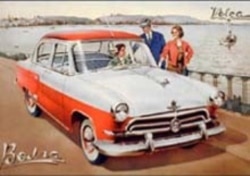Moscow, 9 December 2005 (RFE/RL) -- Russian tycoon Oleg Deripaska, who controls GAZ, confirmed this week that Volga's days were numbered.
"The Volga is a Russian symbol," he said in televised comments from Washington, "but we plan to entirely cease the production of this car," Deripaska said.
Those who had been saving up for a Volga, however, need not despair -- the historic sedan will not immediately disappear from retail.
Oleg Gamov, a GAZ spokesman, told RFE/RL that production will slowly grind to a halt over the next two years.
"The main shareholder noted that the car had become morally obsolete, and this is not a secret to anybody. Production of Volgas will not be halted immediately. A number of cars will be produced in the next two years," Gamov said.
The plant, Gamov said, will then focus entirely on making more profitable vans and trucks.
Status Symbol
The original Volga -- the bulky, but elegant GAZ-21 -- was launched in 1956. With its spacious interior and powerful engine, it soon became a favorite of Communist Party officials.
The follow-up GAZ-24 arrived in 1970 and all variants of the Volga to this day are based on its platform.
The Volga maintained its popularity among mid-level officials and businessmen, and was once affectionately dubbed "Russia's Mercedes." However, this nickname quickly disappeared once its German namesake arrived in Russia and stole the elite's favors.
Soviet citizens unable to afford a Volga were left with the only other option: AvtoVAZ's cheaper Zhiguli, a no-frills, bumpy everyman's car based on an old Fiat design. The Zhiguli and the company went on to adopt the name of its export mark -- the Lada.
Since it announced its decision to ditch the Volga, the GAZ factory has been receiving emails from distressed fans.
Russian President Vladimir Putin himself owns a gleaming 1956 vintage Volga. During a summit last May, he invited U.S. President George W. Bush to drive it around his country residence near Moscow.
Sergei Overchenko, a young man who makes a living as an unofficial cab driver, smiles confidently as he races along Moscow's busy streets at the wheel of his Volga 3100.
His three-year-old Volga, he boasts, is as solid as a tank.
"I work as a driver and almost never leave this car. I am happy with this car, this Volga feeds my family. I am sure it won't let me down. It's like a tank," Overchenko said.
Next time, however, Overchenko admits he could do with a somewhat fresher model and he is already eyeing a Volkswagen.
Cheap Imports
Volga sales have been steadily falling since the collapse of the Soviet Union as cheaper, more reliable foreign cars began to flood the Russian market. Low-prized models from Japan, China, and South Korea are particularly popular with the Russian middle class.
GAZ plans to sell 56,000 Volgas in 2005. This represents a 7-percent drop from last year.
In April, the French Renault carmaker launched a factory in Moscow with ambitious plans to produce some 60,000 vehicles annually. Toyota followed suit a few months later by opening a large assembly plant near the northern city of St. Petersburg.
With prices starting at $7,000 and a fickle reputation for breakdowns, even the most modern versions of the Volga are simply no match.
Aleksandr Rubin bought his Volga 3110 on credit 15 years ago. And he is still ruing the day.
"[My] Volga is constantly breaking, all the details are falling apart -- the suspension rattles, and I pour a liter of oil every month. It's a good thing they are closing it. The Volga's symbol will remain a symbol, but otherwise the Volga is just no good. It's simply an awful car," Rubin said.
Technical blemishes aside, the Volga will long continue to conjure up images of wealth and power.
And when its production finally ends, it is sure to get pride of place in museum as one of the Soviet Union's most enduring symbols.
History Of The Volga

What is today known as the Russian automaker GAZ was founded in 1929. A technology-sharing agreement was reached with the U.S. Ford Motor Company and the foundations were laid for the construction of an automobile-manufacturing plant near Nizhnii Novgorod.
The company was initially known as the Niznii Novgorod Automobile Factory until it was renamed the Gorkii Autombile Factory after the writer Maksim Gorkii.
Soviet versions of Ford's venerable Model A passenger vehicle (the NNAZ A) and Model AA (GAZ AA) truck began rolling off the assembly line in 1932.
After World War II, GAZ celebrated with the introduction of the Pobeda (Victory) and followed on that success with the introduction of the GAZ-21 -- dubbed the Volga -- in 1956. The GAZ-21 Volga was the first Soviet automobile to rival the technology and construction of Western vehicles and was produced until 1970.
In 1970, the company began full-scale production of the GAZ-24 Volga, which featured a design similar to Western sedans of the era. The popular GAZ-24 found a niche as an export vehicle and a station-wagon version was introduced in 1972. Production of the GAZ-24 continued until 1992, and all variants of the Volga manufactured to this day derive from the original GAZ-24.
Attempts were made to modernize the vehicle in the early 1982 with the introduction of the GAZ-3102, which is still manufactured today. The more luxurious 3110 model arrived in 1997 and was produced in large numbers until 2003.
The most extensive remodeling of the Volga resulted in the GAZ-31105, which boasts modern, rounded styling and some foreign-made components and serves today as the luxury model of the Volga lineup.
Production of the Volga reached its peak in the 1990s, reaching more than 100,000 vehicles per year. By 2005, however, the company planned to produce only 56,000 of the vehicles.












